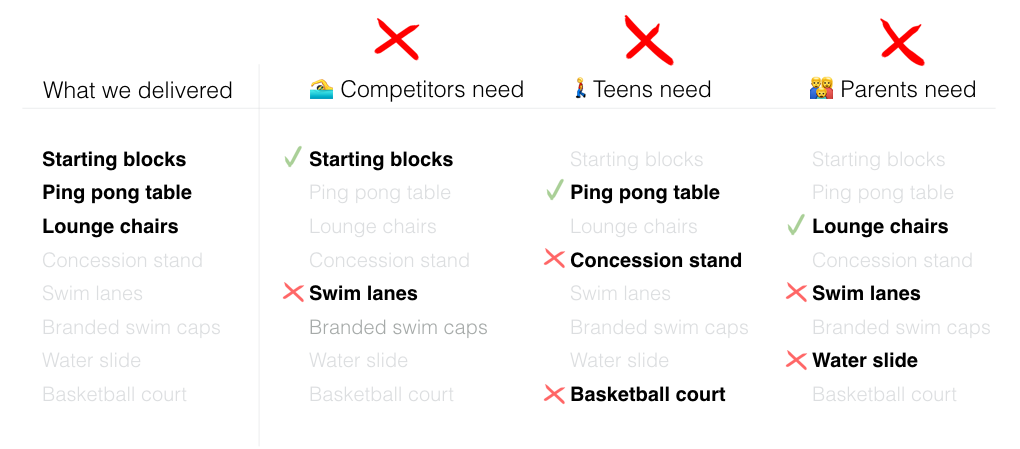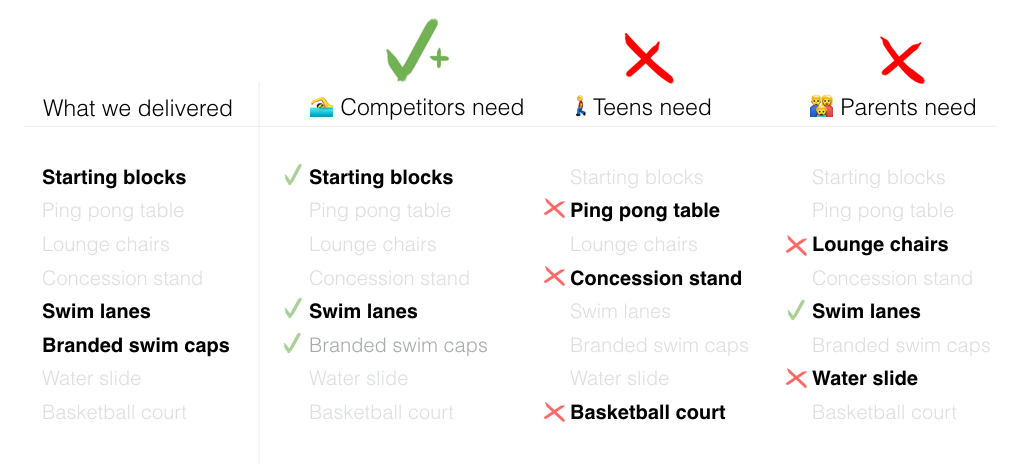User segmentation: Why it’s crucial for product managers

Why product managers should perform user segmentation
In a typical marketplace, not every user has the same needs. But you can usually identify several subgroups of users who have very similar needs to one another. We call these user segments. User segments group together individuals — regardless of whether they work at the same company — based on their behaviors and characteristics.
To understand why this matters, consider what it takes to launch and maintain a successful product. From its earliest stages, your product must meet the needs of some group of users or it will die.
This may seem obvious, but in practice, it’s why many promising products fail. That’s because failing to segment your users is to tacitly accept the myth of the average user. That’s the belief that to successfully prioritize what functionality to build next, you need only build features that address the most frequently voiced needs. Here’s why that’s a recipe for disaster.
Say our product is a new community swimming pool. The top-requested features (and number of requests) are as follows:
- Starting blocks | 17
- Ping pong table | 15
- Lounge chairs | 14
- Concession stand | 12
- Swim lanes | 12
- Branded swim caps | 11
- Water slide | 7
- Basketball court | 4
We have the budget and capacity to choose three of these features by opening day so we choose the top three.
The opening day arrives and we eagerly await to see who subscribes for an annual membership to my pool with starting blocks, a ping pong table, and lounge chairs.
But to our accountant’s horror, no one subscribes!
The myth of the average user
Why aren’t people subscribing? Did they lie about their needs?!
The truth is that further analysis would have shown that in order to subscribe, each segment has a few dealbreakers — requirements that if not met, will ensure they take their business elsewhere.
- Competitive swimmers need starting blocks AND swim lanes
- Teenagers need ping pong AND a concession stand AND a basketball court
- Parents need lounge chairs AND swim lanes for lap swim AND a waterslide (to keep the young’ns busy)
By delivering starting blocks, a ping pong table, and lounge chairs, we incidentally met one dealbreaker for each segment, but did not deliver sufficient functionality to be good enough for any segment.

Implicit in our segmentless prioritization was an assumption that a group of “average users” exists, who would immediately subscribe if only they had starting blocks AND ping pong tables AND lounge chairs. But we’ve discovered that no such average customer exists.
Failing to segment your users is to tacitly accept the myth of the average user.
With poor growth and insufficient revenue, we might be forced to shutter the operation before it got off the ground.
Succeeding with user segmentation (for business to go swimmingly)
If we could rewind and do it over we’d do more when interviewing users than just tally requests. We’d also record who asked for what, how important it is to them (must-have? should-have? nice-to-have?), and what need it solves. Doing so will help identify patterns and discover new segments of users with shared needs and must-have functionality.
Since constraints will only allow us to deliver three features by opening date, we should target the needs of one core group of users. In this case, we’d do best to choose competitive swimmers; membership across teens and parents may fluctuate due to a number of factors (an especially cool summer, a new mall across town, the pool’s reputation for being a good place for families, and so on) but the hardcore competitors will keep coming as long as we deliver their must-have features — starting blocks & swim lanes.
Since we have the capacity for a third feature, we might even consider branded swim caps, which were highly requested by competitive swimmers as a nice-to-have. Doing so means forgoing the ping pong table or lounge chairs until later, but it will sweeten the deal for our early adopters and make our offering stickier. As we now know, choosing another top-rated feature like ping pong or lounge chairs would be a waste, since additional must-haves must be delivered before teens or parents will subscribe.

Not all user segments are created equal
It should now be clear why user segmentation is critical. The hard part is formulating accurate segments around real user needs. In our simplified example above, we pretended we had full access to our prospective customer base and could ask them about their needs one-by-one. What a dream it would be if this were so easy in practice!
In reality, we product managers spend our days wading through a cloudy, amorphous, swirling mass of feature requests, user research, and secondhand reports of what end users are asking for.

The sheer challenge of defining accurate, meaningful segments explains the use of demographic segments like 39-year-old moms with two kids living in the midwest. After all, it’s much easier to identify and market to groups of users defined around concrete characteristics than shared abstract needs. But at the end of the day, demographic segments are only helpful to product teams if they correlate with certain sets of needs.
Great product managers understand how to identify the needs of specific groups within their larger user base so they can provide specific solutions that target those needs. Since comprehensive user research across your entire prospective user base is likely impossible, your best bet is to sample your user base by collecting user inputs on an ongoing basis.
Using a comprehensive product management system like Productboard, you can integrate, collect and organize key user interests in a central feedback repository, including user insights from feature requests, customer support tickets, surveys, check-in meetings, sales calls, and user interviews. You can then search for patterns when it comes to different users’ must-have functionalities.
In time, these patterns will solidify into key user segments, which will form the bedrock of all future prioritization efforts. In Productboard you can create these user segments for feature prioritization by choosing the users you wish to include in an identified segment.
Analyze the needs of different user segments in Productboard
Productboard now lets you define segments based on cohorts you’ve defined in your product analytics solution like Amplitude or Mixpanel. It helps you see what features are most highly requested by your new users, veteran users, power users, or at-risk users. Here’s how it works:
B2B: Understand what your target market segment needs most
If you’re a B2B company, you'll also want to segment at the level of companies — for example, to zero in on the distinct needs of your Enterprise customers, or those from the Media industry, or Aerospace companies that have purchased more than 500 paid seats... With Productboard's dynamic customer segmentation, you can do just that. Get started prioritizing based on the needs of specific customer segments defined by data you've brought in from Salesforce, or other CRMs. Here's how it works:
. . .
Productboard is a product management system that enables teams to get the right products to market faster. Built on top of the Product Excellence framework, Productboard serves as the dedicated system of record for product managers and aligns everyone on the right features to build next. Start your free Productboard trial today




![The CPO’s Blueprint for Annual Planning: An Opportunity to Drive Change [Part 3]](https://www.productboard.com/wp-content/uploads/2024/11/strategy-blueprint-560x293.png)
